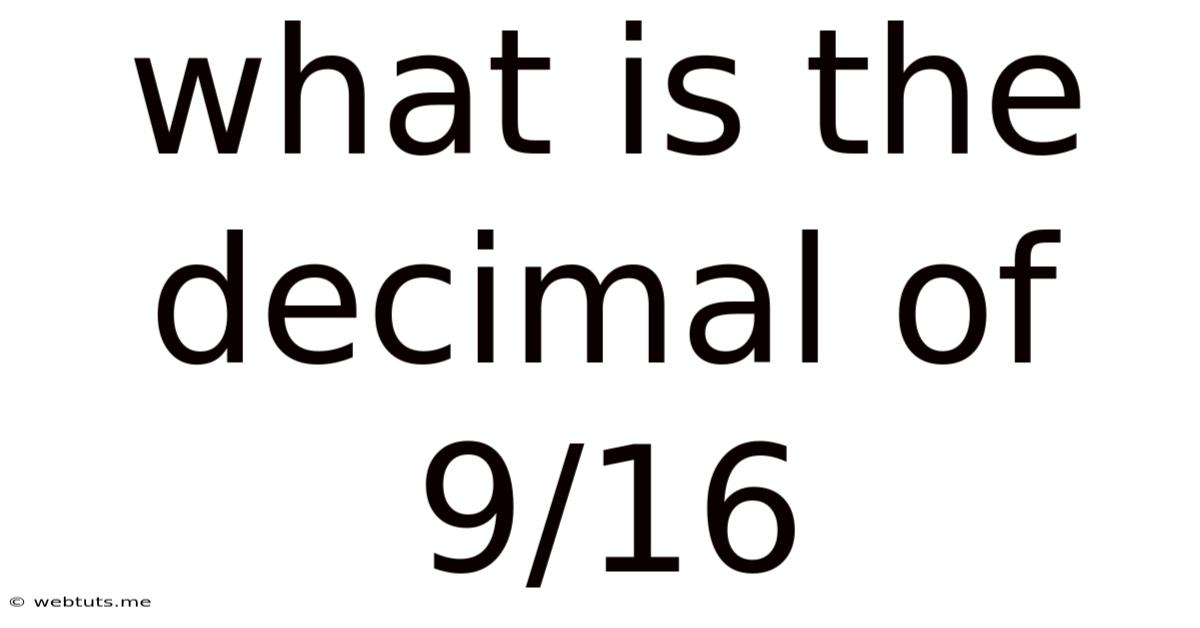What Is The Decimal Of 9/16
Webtuts
May 12, 2025 · 4 min read

Table of Contents
What is the Decimal of 9/16? A Deep Dive into Fraction-to-Decimal Conversion
The question, "What is the decimal of 9/16?" seems simple at first glance. However, understanding the process of converting fractions to decimals reveals a fundamental concept in mathematics with broader applications beyond simple calculations. This comprehensive guide will not only answer the question but also explore the underlying principles, alternative methods, and practical applications of fraction-to-decimal conversion.
Understanding Fractions and Decimals
Before diving into the conversion of 9/16, let's establish a clear understanding of fractions and decimals.
-
Fractions: A fraction represents a part of a whole. It consists of a numerator (the top number) and a denominator (the bottom number). The numerator indicates the number of parts you have, while the denominator indicates the total number of parts the whole is divided into. For example, in the fraction 9/16, 9 represents the number of parts and 16 represents the total number of equal parts that make up the whole.
-
Decimals: A decimal is a way of representing a number using a base-10 system. The digits to the right of the decimal point represent fractions with denominators that are powers of 10 (10, 100, 1000, etc.). For instance, 0.5 is equivalent to 5/10, and 0.25 is equivalent to 25/100.
Methods for Converting 9/16 to a Decimal
There are primarily two methods for converting a fraction to a decimal:
1. Long Division
This is the most straightforward method. You divide the numerator (9) by the denominator (16).
-
Set up the long division: Place the numerator (9) inside the division symbol and the denominator (16) outside. Since 9 is smaller than 16, you'll need to add a decimal point and a zero to the numerator.
-
Perform the division: 16 goes into 90 five times (16 x 5 = 80). Subtract 80 from 90, leaving 10.
-
Continue the process: Add another zero to the remainder (10), making it 100. 16 goes into 100 six times (16 x 6 = 96). Subtract 96 from 100, leaving 4.
-
Repeat: Add another zero to the remainder (4), making it 40. 16 goes into 40 two times (16 x 2 = 32). Subtract 32 from 40, leaving 8.
-
Continue until you reach a repeating pattern or desired accuracy: Add another zero, making it 80. 16 goes into 80 five times. This results in a remainder of 0, meaning the decimal terminates.
Therefore, 9/16 = 0.5625.
2. Converting to an Equivalent Fraction with a Denominator that is a Power of 10
This method involves finding an equivalent fraction where the denominator is 10, 100, 1000, or another power of 10. While this is not always possible, it can be a simpler method for certain fractions. Unfortunately, 16 does not easily convert to a power of 10. You would need to multiply both the numerator and denominator by a number that results in a power of 10 denominator. This isn't practical in this case, making the long division method more efficient.
Understanding Terminating and Repeating Decimals
When converting fractions to decimals, you might encounter two types of decimals:
-
Terminating decimals: These decimals have a finite number of digits after the decimal point. They end. The decimal equivalent of 9/16 (0.5625) is a terminating decimal.
-
Repeating decimals: These decimals have an infinite number of digits after the decimal point, where a sequence of digits repeats indefinitely. For example, 1/3 = 0.3333... (the 3 repeats infinitely).
Practical Applications of Fraction-to-Decimal Conversion
The ability to convert fractions to decimals is crucial in various fields:
-
Engineering and Construction: Precise measurements are essential. Converting fractions to decimals allows for more accurate calculations in blueprints and designs.
-
Finance: Calculating interest rates, discounts, and other financial transactions often involve working with both fractions and decimals.
-
Science: Many scientific measurements and calculations involve fractions that need to be converted to decimals for easier computation and analysis.
-
Computer Programming: Converting fractions to decimals is necessary for representing numerical values in computer programs.
-
Everyday Life: From baking (measuring ingredients) to splitting bills, understanding fraction-to-decimal conversion is useful in various everyday scenarios.
Beyond 9/16: Exploring Other Fraction-to-Decimal Conversions
Let's briefly explore some other fraction-to-decimal conversions to solidify our understanding:
-
1/2: This is a simple one: 1/2 = 0.5
-
1/4: 1/4 = 0.25
-
3/4: 3/4 = 0.75
-
1/3: This results in a repeating decimal: 1/3 = 0.3333...
-
1/8: 1/8 = 0.125
-
5/8: 5/8 = 0.625
-
7/8: 7/8 = 0.875
By practicing these conversions, you will become more comfortable and efficient in converting fractions to decimals.
Conclusion
The decimal equivalent of 9/16 is 0.5625. This seemingly simple conversion highlights the fundamental relationship between fractions and decimals, both crucial components in various mathematical applications. Understanding the methods of conversion, recognizing terminating and repeating decimals, and appreciating the practical applications will empower you to handle numerical computations with confidence and accuracy in diverse contexts. Whether you're an engineering student, a financial professional, or simply someone who wants to enhance their mathematical understanding, mastering fraction-to-decimal conversion is an invaluable skill.
Latest Posts
Latest Posts
-
107 Inches Is How Many Feet
May 14, 2025
-
1 Litre Of Milk In Cups
May 14, 2025
-
How Many Years Ago Was 1965 To 2024
May 14, 2025
-
How Many More Days Until August 29th
May 14, 2025
-
How Many Tons Are In 20000 Pounds
May 14, 2025
Related Post
Thank you for visiting our website which covers about What Is The Decimal Of 9/16 . We hope the information provided has been useful to you. Feel free to contact us if you have any questions or need further assistance. See you next time and don't miss to bookmark.